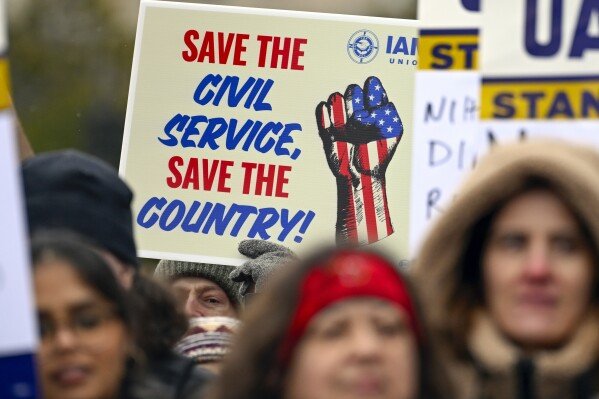
Why Public Protest Could Strengthen Trump’s Support Among Voters
Public protests targeting Trump—especially over Social Security—could actually strengthen his support base. Emotional bonds, group identity, and media backlash often reinforce voter loyalty rather than diminish it.
Potential consequences of public protests against Donald Trump, particularly regarding Social Security, and how this could affect his support among voters. It delves into the psychological factors at play and examines voter loyalty, public opinion, and the nature of political protests, offering insights and anecdotes.
In the chaotic realm of American politics, we’ve all seen moments where a politician faces significant public outcry. I recall watching one such event unfold during a town hall meeting, where constituents passionately spoke against proposed changes to their beloved Social Security. Surprisingly, instead of swaying public sentiment, it solidified loyalty among a certain demographic, much like Trump’s fervent supporters. This observation begs the question: could Trump’s confrontation with protests over Social Security boost his popularity instead of diminishing it?
The Psychology Behind Political Loyalty
Political loyalty is a fascinating topic. It dives deep into the human psyche. Why do people stick with a candidate? What makes them defend their beliefs, even when logic suggests otherwise? Understanding the psychology behind this loyalty reveals much about our emotional connections and shared values.
Emotional Connections and Voter Loyalty
Emotions play a crucial role in shaping political loyalty. When voters feel a strong emotional connection to a candidate, they are more likely to remain loyal. This connection can stem from various factors:
- Personal Stories: Candidates often share personal anecdotes that resonate with voters. These stories create a sense of familiarity.
- Empathy: When voters see a candidate who understands their struggles, they feel seen and heard.
- Charisma: A candidate’s charisma can draw people in. Charismatic leaders often inspire loyalty simply through their presence.
But why do these emotional ties matter? They can override rational thought. Voters may support a candidate despite evidence that contradicts their beliefs. This phenomenon is evident in many passionate electorates. It raises the question: Are we more driven by our hearts than our heads?
Shared Beliefs and Values
Another significant factor in political loyalty is the impact of shared beliefs and values. When voters identify with a candidate’s ideology, they form a bond. This bond is often stronger than any disagreement they might have.
- Common Goals: Voters who share a vision for the future are more likely to support a candidate who aligns with that vision.
- Community Identity: Belonging to a group that shares similar values fosters loyalty. People want to feel part of something bigger.
- Reinforcement: When a candidate expresses values that resonate with their supporters, it reinforces their loyalty.
As a political analyst once noted,
“Political loyalty is often rooted not in agreement, but in shared struggles and collective identity.”
This statement captures the essence of why shared beliefs can create such strong bonds between candidates and their supporters.
Protests and Political Support
Protests can also play a pivotal role in strengthening political loyalty. When supporters rally behind a cause, it often galvanizes their commitment. This is particularly true in cases where a candidate faces public opposition.
- Unity in Action: Protests can unite supporters. They come together for a common cause, reinforcing their loyalty.
- Visibility: Public protests can draw attention to issues. This visibility can strengthen the resolve of supporters.
- Emotional Charge: The energy of a protest can create a powerful emotional experience. This experience can deepen loyalty.
Public opinion experts have noted that
“Protests can galvanize supporters, making them more committed to their cause.”
This highlights how collective action can enhance political loyalty. When people see others fighting for a cause, it can ignite their passion and commitment.
Case Studies of Loyalty Through Protest
Several case studies illustrate how protests have strengthened political support. For instance, during the civil rights movement, many leaders gained unwavering loyalty from their supporters. The protests were not just about policy; they were about identity and justice. This emotional connection fostered a deep loyalty that transcended individual disagreements.
Similarly, recent movements have shown how protests can rally support around a candidate. When people feel that their rights are being threatened, they often rally behind those who stand with them. This creates a powerful emotional bond that can last long after the protests have ended.
The psychology behind political loyalty is complex. Emotional connections, shared beliefs, and the impact of protests all play significant roles. Understanding these elements can provide insight into why voters remain loyal, even in the face of adversity. It raises important questions about the nature of loyalty itself. Are we driven by our emotions, our beliefs, or a combination of both? The answer may vary from person to person, but one thing is clear: political loyalty is a deeply human experience.
Historical Context: Protests and Political Resilience
Understanding the historical context of protests is crucial. It helps frame current events and voter reactions. Political landscapes are often shaped by the actions of leaders during times of unrest. Some politicians even thrive amid controversy. But how does this happen? What can history teach us about voter sentiment in response to protests?
Examples of Politicians Who Thrived Amid Controversy
Throughout history, several politicians have managed to turn controversy into an advantage. They have faced protests and backlash but emerged stronger. For instance:
- Franklin D. Roosevelt: During the Great Depression, he faced significant protests. Yet, his New Deal policies garnered immense support. People saw him as a leader who cared.
- Richard Nixon: Despite the Watergate scandal, Nixon maintained a loyal base. His supporters believed he was a victim of political maneuvering.
- Donald Trump: His presidency saw numerous protests. Yet, many of his supporters felt these protests only validated his stance. They viewed him as a fighter against the establishment.
These examples illustrate a pattern. Controversy can rally core supporters. It creates a narrative of resilience. But why does this happen?
How Protests Have Historically Impacted Voter Sentiment
Protests often serve as a barometer for public sentiment. They can sway opinions, but the effects are not always straightforward. Historically, protests have led to:
- Increased Engagement: Protests can mobilize voters. They often inspire people to become more politically active.
- Polarization: On the flip side, protests can deepen divisions. Supporters of a cause may become more entrenched in their views.
- Shift in Loyalty: Some voters may switch allegiance based on how politicians respond to protests. A strong, decisive response can win over undecided voters.
For example, during the Civil Rights Movement, protests led to significant legislative changes. Leaders who supported these movements often gained favor with the public. Conversely, those who opposed them faced backlash. This highlights the dual nature of protests: they can both unite and divide.
Comparative Analysis of Voter Behavior in Response to Protests
When analyzing voter behavior, it’s essential to consider context. Different protests elicit varied responses. For instance, protests against racial injustice may resonate differently than those against economic policies. Here are some key factors to consider:
- Nature of the Protest: Peaceful protests often garner sympathy. Violent protests may lead to fear and backlash.
- Media Coverage: How protests are portrayed in the media can shape public perception. Positive coverage can enhance support, while negative coverage can diminish it.
- Political Climate: The current political environment plays a significant role. In a polarized climate, protests may reinforce existing beliefs rather than change minds.
For instance, during the Women’s March in 2017, many voters felt empowered. The protest highlighted issues of gender equality and mobilized a significant voter base. In contrast, protests that are perceived as disruptive may alienate moderate voters.
“History shows us that controversy can often bolster a leader’s reputation among core supporters.” – Historian.
This quote encapsulates a vital truth about political resilience. Leaders can leverage controversy to strengthen their base. They can frame themselves as defenders of their supporters’ values. This dynamic is crucial in understanding how protests influence political landscapes.
Historical context provides valuable insights into current events. By examining past trends, we can better understand voter reactions. Protests have always played a significant role in shaping political narratives. They impact voter sentiment in complex ways. As history shows, the relationship between protests and political resilience is intricate and multifaceted.
The Role of Social Media in Shaping Opinions
Social media has transformed how people communicate, especially during protests. It has become a powerful tool for amplifying voices that might otherwise go unheard. In this digital age, the dynamics of political communication have shifted dramatically. This change is evident in how protests are organized, perceived, and responded to.
Amplifying Voices During Protests
When protests occur, social media platforms like Twitter, Facebook, and Instagram serve as megaphones. They allow individuals to share their experiences and opinions with a global audience. This amplification is crucial. It gives a voice to the marginalized and helps to rally support. For instance, during the Black Lives Matter protests, social media played a pivotal role in spreading awareness and mobilizing people across various cities.
But how does this amplification happen? It’s simple. A single tweet or post can go viral, reaching thousands or even millions in a matter of hours. This rapid dissemination of information can change the narrative surrounding a protest. It can highlight injustices and spark conversations that might not have occurred otherwise. In the words of a sociologist,
“In the age of social media, protests take on a life of their own, spreading narratives quickly and broadly.”
The Effect of Viral Content on Political Loyalty
Viral content can significantly impact political loyalty. When a protest or a political figure becomes a trending topic, it can sway public opinion. People often form their views based on what they see online. If a protest is portrayed positively, it can enhance support for the cause. Conversely, negative portrayals can diminish it.
Consider the case of former President Donald Trump. His supporters often rallied around him more fiercely when he faced protests. Social media played a crucial role in this dynamic. Viral videos of protests against him sometimes led to increased loyalty among his base. They perceived these protests as attacks on their beliefs. This phenomenon illustrates how social media can create an echo chamber, reinforcing existing loyalties rather than challenging them.
Case Studies of Social Media Reactions to Protests Against Trump
Numerous case studies highlight the relationship between social media and protests against Trump. For example, during the Women’s March in 2017, social media was instrumental in organizing events across the globe. The hashtag #WomensMarch trended worldwide, showcasing the power of collective action. People shared their stories, experiences, and reasons for protesting, creating a sense of community.
Another notable instance was the protests surrounding Trump’s immigration policies. Social media users shared personal stories of families affected by these policies. This humanization of the issue helped garner widespread support. It also sparked debates that extended beyond the protests themselves. The rapid spread of these narratives often led to increased public scrutiny of the administration’s actions.
However, not all reactions were positive. Some social media users criticized the protests, labeling them as ineffective or misguided. This backlash demonstrates the dual-edged nature of social media. While it can amplify voices, it can also foster division and dissent.
In conclusion, social media has drastically changed the landscape of political communications and protests. It amplifies voices, shapes narratives, and influences public opinion. Viral moments can shift perceptions within hours, making it a powerful tool for both activists and politicians. As society continues to navigate this digital age, understanding the role of social media in shaping opinions becomes increasingly vital. The implications are profound, affecting everything from individual beliefs to national policies. As we move forward, one must consider how these platforms will continue to influence the political landscape.
TL;DR: Public protest against Trump regarding Social Security may lead to increased loyalty among his base, further complicating the political landscape.
VoterPsychology, PoliticalProtest2023, PoliticalBacklash, PublicOpinionDynamics, ProtestImpact, SupportForTrump, SocialSecurityProtest, TrumpProtestReactions, TrumpSupporters, PoliticalLoyalty
#VoterPsychology, #SocialSecurityProtest, #PoliticalProtest2023, #PoliticalLoyalty, #SupportForTrump, #PublicOpinionDynamics, #TrumpSupporters, #PoliticalBacklash, #TrumpProtestReactions, #ProtestImpact,#TrumpProtests, #VoterLoyalty, #PoliticalPsychology, #PublicProtest, #SocialSecurity, #TrumpBase, #MediaNarratives, #PoliticalSupport, #ProtestBacklash, #SocialMediaPolitics

